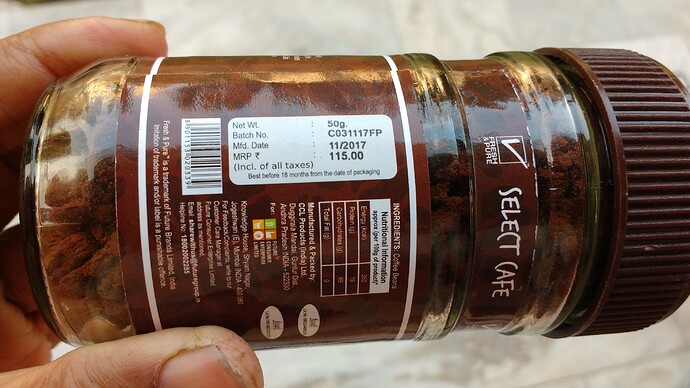After reading this article you may think twice before drinking any exotic coffee.
Spilling the coffee beans
12/18/2017
Votaries of the brew are ready to spend hefty sums for favourite blends
Jackie Chan once famously said that coffee is a language in itself, and votaries of the brew would agree, revelling as they do in its complex aromatic grammar and social semantics.
A steaming mug of coffee kick-starts the mornings of millions every day. Perfectly blended and brewed, your favourite can cost anywhere between $1 and $500, but, for those who love the beverage, it’s a price worth paying. For there is nothing that can beat the aroma, flavour and feel of that perfect cup.
Surprisingly, the several versions of coffee — latte, espresso, cappucino or mocha — are made primarily from two types of beans — Arabica and Robusta.
Over the years, both the variety and quality of coffees has improved dramatically.
Avid coffee lovers are ready to fork out hefty sums for their favourite blends and producers have been outdoing themselves in catering to this clientele by offering beans grown in special climatic conditions or processed in strange ways, sometimes involving animal poo!
For instance, the Indonesian Kopi luwak, one of the world’s most expensive brews, is made from part-digested coffee cherries eaten and excreted by the Asian palm civet.
What influences the price
Coffee shops across different regions and countries charge different prices based on the size of the coffee, type or blend, and the specific variety chosen. Arabica, for instance, is pricier than Robusta as the latter is easy to grow but has a harsh, strong and bitter taste.
Arabica has a sweet and smooth flavour but is grown at high altitudes and takes a long time to bear fruit, usually over a year. Thus, it is a common practice to blend the two to balance the taste.
That said, the beans are not the only factor that determine a coffee’s price. Rahul Leekha, owner and director of Coffee by Di Bella (India), says there are wide price variations within a country and its regions that are largely attributed to climatic conditions, soil, the flavours added and the harvest volume.
Global output is another factor affecting the price of your steaming mugful, as also the method of production. Some coffees taste better as the trees are older and well-maintained and, hence, their price is higher. Other specialty coffees, especially the ones produced from animal faeces, are sold at very high prices, because of the way the beans are roasted and brewed.
Exclusive coffee
“You can make all kinds of wines with different varieties of grapes, but the premium wines are those made from grapes grown in specific regions, which have their own unique tastes. The same applies to coffee also,” says Leekha.
It is not what is being added to a coffee but the factors that contribute to the production of the coffee that makes it expensive. For instance, Panama Geisha coffee, from Panama is considered the most expensive in the world.
This particular coffee has a high demand and is usually grown 1,500 metres above the sea level.
Production is also very limited; hence, the high price. Says Leekha: “In a coffee auction recently, Panama Geisha fully Arabica coffee, was auctioned at a record breaking $37,000 for 100 pounds.
It is the only type of coffee grown in those regions and has a unique and complex flavour with notes of tropical fruits in it — a perfect balance.”
Blue mountain coffee is another popular, high-end product grown in the mountains of Jamaica. The cherries are grown at an altitude of 7,500 feet above sea level; the climatic conditions and soil give the roast a mild taste.
Japan buys almost 80 per cent of this coffee and is partly responsible for its high demand.
Coffee such as Hacienda El Roble, a rare coffee grown in Colombia, is also expensive mainly because of limited supply.
Di Bella’s Leekha says “Only 22 kilos of this coffee is available each year, it is very exclusive and has a unique taste. It easily costs upward of around $300 a cup.” Coffees grown in volcanic regions, because of the soil, enjoy a premium pricing too.
Bizarre beans
Some coffee growers use highly unusual methods to produce coffees that surprisingly seem to find favour and feature in the premium pricing segment. For instance, Black Ivory, is among the notably expensive coffees globally, produced in North Thailand.
Here, the Arabica cherries are fed to the elephants. The cherries pick up unique flavours as they pass through the elephants’ intestines. When excreted by elephants, they are smoother, less bitter.
These fruit are then roasted, processed and sold. Since only few of the cherries survive the production process, this coffee is considered super expensive, around $1,500 a pound.
Kopi Luwak is also expensive for the same reason. In this case, the cats eat and excrete a combination of both Arabica and Robusta cherries, bringing out a unique blend each time that costs $200-$600 per pound.
Besides the manner of production, the additives — flavours, fruits and other ingredients — can also enhance the taste.
So, next time you buy coffee, find out what type of beans, and the proportion of beans, used in the blend, ask how it’s been roasted — light, medium or dark. Then pick the flavours or ingredients you want in your coffee.
And if you prefer the exotic, go for ones that have passed through the innards of some beast.

